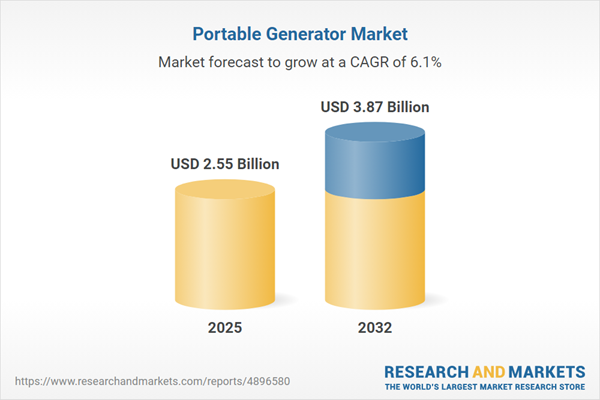Speak directly to the analyst to clarify any post sales queries you may have.
Senior decision-makers are increasingly turning to portable generator solutions to minimize operational risk, maintain compliance, and strengthen business resilience in today’s unpredictable power environment. For organizations with critical infrastructure and evolving needs, portable backup generators have become integral assets supporting business continuity.
Market Snapshot: Portable Generator Market Size and Growth
The portable generator market grew from USD 2.40 billion in 2024 to USD 2.55 billion by 2025, with ongoing growth expected at a CAGR of 6.14% and the market projected to reach USD 3.87 billion by 2032. This expansion is fueled by factors such as severe weather events, aging grid systems, new tariffs, and a shift toward renewable energy sources. As power disruption becomes more frequent, organizations rely on portable generators to uphold uninterrupted business operations during outages.
Scope & Segmentation of the Portable Generator Market
This report examines the primary drivers impacting the portable generator sector. It highlights technology shifts, compliance priorities, and detailed segmentation, enabling robust procurement and competitive strategy. The following aspects define the market landscape:
- Operation Modes: Organizations may deploy automatic or manual generator operation to align with distinctive power recovery plans.
- Fuel Types: Diesel and gasoline models are selected based on workload and unique operational profiles across different industry verticals.
- Sales Channels: Direct sales, dealer networks, rental services, retail outlets, and online platforms ensure flexible and efficient procurement.
- Application Areas: Utilization spans emergency backup for vital facilities, peak load management in industrial contexts, and off-grid support for sectors such as construction and telecommunications.
- End Users: Agricultural enterprises, commercial operations, construction firms, event organizers, large industrial plants, and residential buyers each prioritize portable generators for specific reliability objectives.
- Regional Coverage: Includes the Americas (United States, Canada, Mexico, Latin America), Europe, Middle East & Africa (UK, Germany, France, Italy, Spain, Russia, UAE, Saudi Arabia, South Africa, and others), and Asia-Pacific (China, India, Japan, Australia, South Korea, Southeast Asia), with each region experiencing unique demand drivers and adoption trends.
- Technology Solutions: Advances such as digital control panels, noise-reduction systems, emission compliance solutions, and modular units streamline monitoring, support regulatory needs, and reduce workplace disruption.
- Leading Manufacturers: Major suppliers include Generac Power Systems, Honda Motor, Yamaha Motor, Cummins, Atlas Copco, Caterpillar, Hyundai Motor, Mitsubishi Heavy Industries, Kubota Corporation, and Wacker Neuson SE.
Key Takeaways for Strategic Planning
- Portable generators are increasingly seen as critical tools to counteract grid instability, particularly in sectors requiring consistent uptime, such as healthcare, industrial manufacturing, and telecommunications.
- Recent technological features, including digital interfaces and advanced noise and emission management, help organizations comply with emerging performance and regulatory expectations.
- Remote monitoring capabilities support stronger asset oversight and easier maintenance for organizations managing distributed or multi-site operations, improving responsiveness to outages or malfunctions.
- Accelerating regulatory changes are prompting enterprises and manufacturers to prioritize designs and procurement that reflect environmentally responsible standards across major markets.
- Regional trends—driven by variations in infrastructure investment, urban development, and changes in energy policy—significantly influence portable generator adoption patterns across Asia-Pacific, the Americas, and EMEA.
Tariff Impact on Market Structure
Recent U.S. tariffs on imported generator components have altered manufacturing cost models, posing new supply chain challenges. Enterprises are responding by exploring nearshoring options, expanding supplier networks, and establishing regional partnerships. These adaptive procurement strategies help manage cost volatility and ensure resilient generator sourcing in a shifting economic landscape.
Methodology & Data Sources
The research approach integrates primary interview data, analysis of technical literature, and review of regulatory documentation. In-depth supply chain assessments and scenario modeling ensure the report delivers intelligence that is both actionable and reflective of real procurement conditions in the portable generator market.
Why This Report Matters for Portable Generator Market Stakeholders
- Enables benchmarking of technology portfolios and operating models in the context of evolving regulatory requirements and industry landscapes.
- Gives procurement teams clear guidance for managing risks related to tariffs and market-specific sourcing, empowering development of stronger, more resilient supply chains.
- Clarifies growth-driving trends and use-case patterns, making business continuity planning and targeted investments more effective for organizations across different sectors.
Conclusion
Organizations that leverage up-to-date intelligence and agile generator solutions are best equipped to mitigate disruption and ensure operational continuity in a changing energy landscape. Strategic generator adoption remains essential for long-term resilience and competitive positioning.
Additional Product Information:
- Purchase of this report includes 1 year online access with quarterly updates.
- This report can be updated on request. Please contact our Customer Experience team using the Ask a Question widget on our website.
Table of Contents
3. Executive Summary
4. Market Overview
7. Cumulative Impact of Artificial Intelligence 2025
List of Figures
Samples

LOADING...
Companies Mentioned
The key companies profiled in this Portable Generator market report include:- Generac Power Systems, Inc.
- Honda Motor Co., Ltd.
- Yamaha Motor Co., Ltd.
- Cummins Inc.
- Atlas Copco AB
- Caterpillar Inc.
- Hyundai Motor Company
- Mitsubishi Heavy Industries, Ltd.
- Kubota Corporation
- Wacker Neuson SE
Table Information
| Report Attribute | Details |
|---|---|
| No. of Pages | 185 |
| Published | October 2025 |
| Forecast Period | 2025 - 2032 |
| Estimated Market Value ( USD | $ 2.55 Billion |
| Forecasted Market Value ( USD | $ 3.87 Billion |
| Compound Annual Growth Rate | 6.1% |
| Regions Covered | Global |
| No. of Companies Mentioned | 11 |









